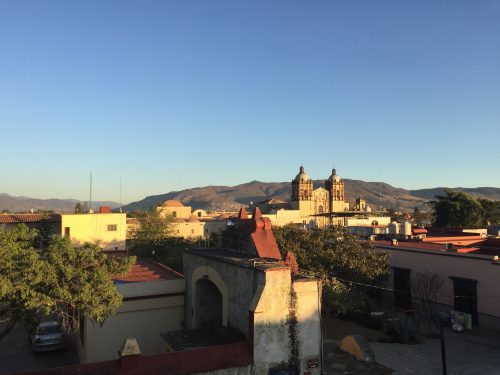BY DEBORAH HAGMAN-SHANNON
Responsible Tourism in Oaxaca Mexico
There are many reasons to visit the lovely state of Oaxaca in southern Mexico. The indigenous peoples, the innovative and emerging art scene, the delicious food, and the amazing and colorful markets all combine to make Oaxaca a stimulating, engaging place to be. We enjoyed all of these things during our recent trip in January. But, surprisingly, the aspect of my trip I most treasured was the day spent with Fundación En Vía.
En Vía, translated, means “on the path.” Founded in 2008, En Vía provides interest-free microloans and financial education to the women of the indigenous communities around the city of Oaxaca. A microloan is truly small in our terms—anywhere from US $100 to US $250—and yet, for these women, these loans are life-changing. Without these funds, their opportunities for loans—which are typically not even made to women—are through local banks, with interest rates of 70 to 150 percent.
En Vía, at its inception, determined that loans to businesses owned and operated by women would have the most significant chance of being repaid, and, in addition, would have the greatest positive impact on families and communities. Thus, the foundation makes loans only to women.
As a tourist, I experienced En Vía’s mission by participating in one of their daylong tours to visit a few of the women who have benefited from a microloan. For a fee of $45 per person, most of which constitutes a donation to the En Vía loan fund, a group of us loaded an En Vía-owned van at 9 a.m. and began our trek to the villages of Santa Domingo Tomaltepec and San Miguel, about 20 km southeast of the city of Oaxaca.
Getting to these places required driving on unfinished, dusty roads through quiet, poor communities where citizens were going about their daily work, whether tending the animals or minding a local shop. I was struck by how bright and peaceful everything was. Adobe homes were modest and glass windows nonexistent, animals roamed freely, and flowers and gardens were few and far between as January is the heart of the dry season.
Our guides for the day, Natalie and Sarah, are students, one from America and the other from Germany, who are in Oaxaca to study art, perfect their Spanish, and volunteer their time to efforts like this one. They were knowledgeable, compassionate, and fun—I could see how much they cared about the women, these communities, and the work of En Vía.
The first stop on our tour was at the home of Lucia, a middle-aged woman who employs her children, daughter-in-law, and cousins in the manufacturing of leather goods. Leatherwork is a skill that has been passed from generation to generation in the village of Santo Domingo Tomaltepec. Lucia started her business several years ago, largely utilizing tools and techniques that harken back to previous generations. With a microloan from En Vía, Lucia was able purchase her first sewing machine, attend En Vía sponsored classes on the basics of managing money and business affairs, and, thus, expand her product line and marketing efforts.
The tour took our small group to her home, where we could observe family members churning out leather wallets, purses, and various other leather goods in a room that was once a living area. I was impressed with the energy, the interest in good design, and the intensity of all the workers. Their products are sold in a couple of the artisan shops in Oaxaca but part of the tour included the opportunity to purchase from Lucia directly, which most of us did. This is yet another way in which clients of En Vía benefit—I estimated that our group spent over US $100 within the few minutes available for shopping, a modest amount in US terms but significant for Lucia and her family.
En Vía supports about 250 women at any given point, and they rotate the tours so that each woman can benefit from these direct, in-home purchases. Interestingly, Lucia is now partnering with other local craftspeople to incorporate embroidered fabrics into her products, thereby extending the impact of En Vía funding in this community even further.
It isn’t surprising that En Vía has generous repayment terms for the loans. Clients are required to make modest installments every few weeks and with reasonable notice can forego a payment without penalty if necessary. The loan repayment rate is over 90 percent, and most women receive multiple loans in order to fully develop their businesses.
En Vía funds a wide range of businesses, and their goal is to make it possible for the women to be more prosperous while remaining in their home communities. My tour was perfect example: after the leatherwork business, we were taken to the home of a woman who cooks desserts and sells them in her local community. An initial microloan enabled her to purchase Tupperware containers for food storage.
Successful on-time repayment of loans qualifies participants to reapply for successively larger loan amounts. Thus, as soon as this enterprising cook is able to repay En Vía, she plans to apply for a larger loan to purchase a refrigerator. Can you imagine operating a food business without a refrigerator? This, in addition to the fact that she cooks on a wood stove—such energy, resourcefulness and determination!
Other businesses on our tour included a restaurant, an embroidery business, and two textile/weaving businesses. In all cases, the loan recipients employed family members and partnered with neighbors and others in their communities, fully demonstrating the wisdom of the En Vía mission to focus on women.
I sampled and purchased products everywhere we went because the quality was superb and the prices were shockingly low. Others in my group did similarly. Whether it was finding the freshest milk for the desserts or growing the flowers and plants to be used in creating natural dyes for the woolen threads, these women and their families worked together to create wonderful food, textiles, leather goods, and clothing.
Throughout the day, I was reminded that being a responsible tourist is all about connecting to local life, spending time away from the typical tourist destinations, and focusing more deeply on the life experience for those who are residents. In the end, my trip to Oaxaca did include the sophisticated galleries, fine food, and lively markets that I expected. But it also brought an unexpected opportunity to connect with fellow human beings by tuning in to their lives, their challenges, and personal journeys as they work to improve life for themselves, their families, and their communities.
Fundación En Vía offers an effective, accessible economic development model, and the daylong tours to connect with En Vía loan participants are there for anyone visiting Oaxaca. To learn more, please check out their website at www.envia.org.










